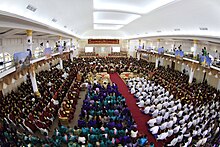According to the UNESCO Institute of Statistics, Burma's official literacy rate as of 2000 was 89.9%.[243] Historically, Burma has had high literacy rates. To qualify for least developed country status by the UN in order to receive debt relief, Burma lowered its official literacy rate from 78.6% to 18.7% in 1987.[244][clarification needed]
Burma is ethnically diverse. The government recognises 135 distinct ethnic groups. While it is extremely difficult to verify this statement, there are at least 108 different ethnolinguistic groups in Burma, consisting mainly of distinct Tibeto-Burman peoples, but with sizeable populations of Tai–Kadai, Hmong–Mien, and Austroasiatic (Mon–Khmer) peoples.[245] The Bamar form an estimated 68% of the population.[246] 10% of the population are Shan.[246] The Kayin make up 7% of the population.[246] The Rakhine people constitute 4% of the population. Overseas Chinese form approximately 3% of the population.[246][247] Burma's ethnic minority groups prefer the term "ethnic nationality" over "ethnic minority" as the term "minority" furthers their sense of insecurity in the face of what is often described as "Burmanisation"—the proliferation and domination of the dominant Bamar culture over minority cultures.
Mon, who form 2% of the population, are ethno-linguistically related to the Khmer.[246] Overseas Indians are 2%.[246] The remainder are Kachin, Chin, Anglo-Indians, Gurkha, Nepali and other ethnic minorities. Included in this group are the Anglo-Burmese. Once forming a large and influential community, the Anglo-Burmese left the country in steady streams from 1958 onwards, principally to Australia and the U.K.. Today, it is estimated that only 52,000 Anglo-Burmese remain in the country. There are 110,000 Burmese refugees in Thai border camps.[248]
89% of the country's population are Buddhist, according to a report on ABC World News Tonight in May 2008 and the Buddha Dharma Education Association.[249]
Language
Main article: Languages of Burma
Burmese, the mother tongue of the Bamar and official language of Burma, is related to Tibetan and to the Chinese languages.[242] It is written in a script consisting of circular and semi-circular letters, which were adapted from the Mon script,
which in turn was developed from a southern Indian script in the 8th
century. The earliest known inscriptions in the Burmese script date from
the 11th century. It is also used to write Pali,
the sacred language of Theravada Buddhism, as well as several ethnic
minority languages, including Shan, several Karen dialects, and Kayah
(Karenni), with the addition of specialised characters and diacritics for each language.[250] The Burmese language incorporates widespread usage of honorifics and is age-oriented.[251] Burmese society has traditionally stressed the importance of education. In villages, secular schooling often takes place in monasteries. Secondary and tertiary education take place at government schools.Religion
Main articles: Religion in Burma, Buddhism in Burma, Hinduism in Burma, Christianity in Burma, Islam in Burma, and History of the Jews in Burma
Many religions are practised in Burma. Religious edifices and orders
have been in existence for many years. Festivals can be held on a grand
scale. The Christian and Muslim populations do, however, face religious
persecution and it is hard, if not impossible, for non-Buddhists to join
the army or get government jobs, the main route to success in the
country.[252]
Such persecution and targeting of civilians is particularly notable in
Eastern Burma, where over 3000 villages have been destroyed in the past
ten years.[253][254][255] More than 200,000 Rohingya Muslims have settled in Bangladesh over the last 20 years to escape persecution.[256]
In February 2012, 1000 Buddhist monks and followers gathered for the 18th annual Shwegyin Nikaya Conference at the compound of Dhammaduta Zetawon Tawya Monastery in Hmawbi Township, Yangon Region.
Although Hinduism is presently only practiced by 1% of the population, it was a major religion in Burma's past. Several strains of Hinduism existed alongside both Theravada Buddhism and Mahayana Buddhism in the Pyu period in the first millennium CE,[262] and down to the Pagan period (9th to 13th centuries) when "Saivite and Vaishana elements enjoyed greater elite influence than they would later do."[263]
Tidak ada komentar:
Posting Komentar